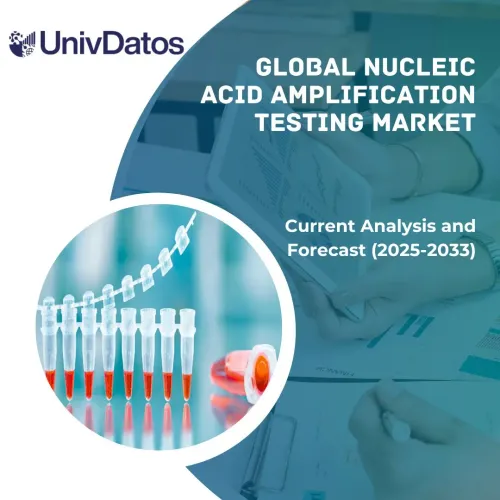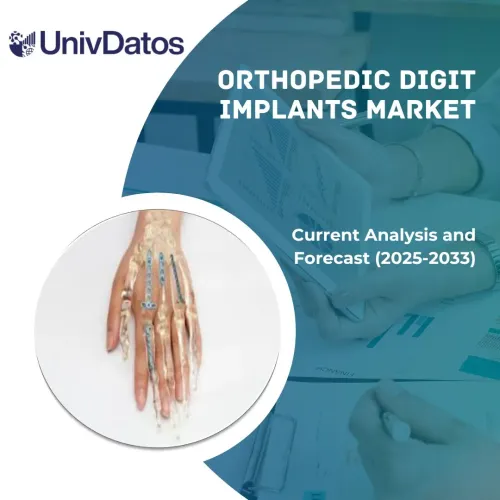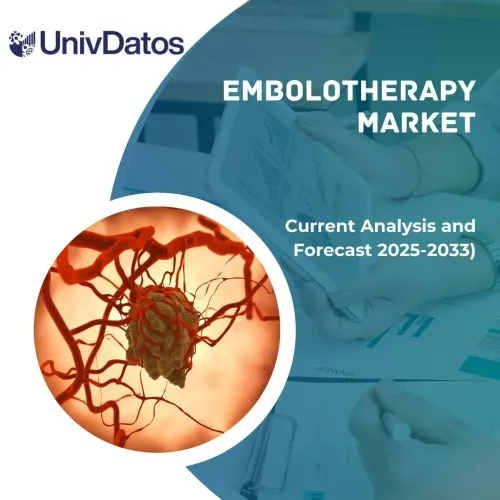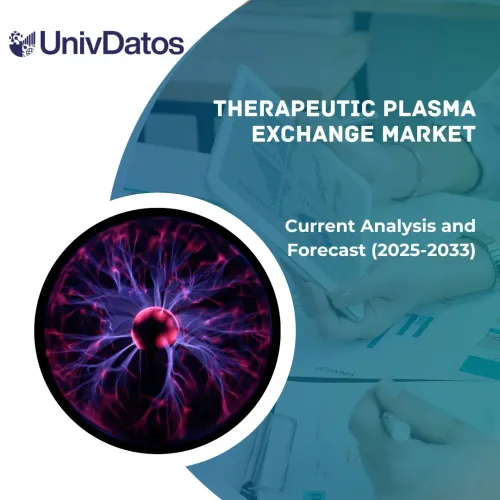- Home
- About Us
- Industry
- Services
- Reading
- Contact Us
Gynecological Cancers Therapeutics Market: Current Analysis and Forecast (2023-2030)
Emphasis on Cancer Type (Cervical Cancer, Uterine Cancer, Ovarian Cancer, and Others); Treatment Type (Chemotherapy, Targeted Therapy, and Others); Distribution Channel (Hospitals Pharmacies, Retail Pharmacies, and Online Pharmacies); and Region/Country
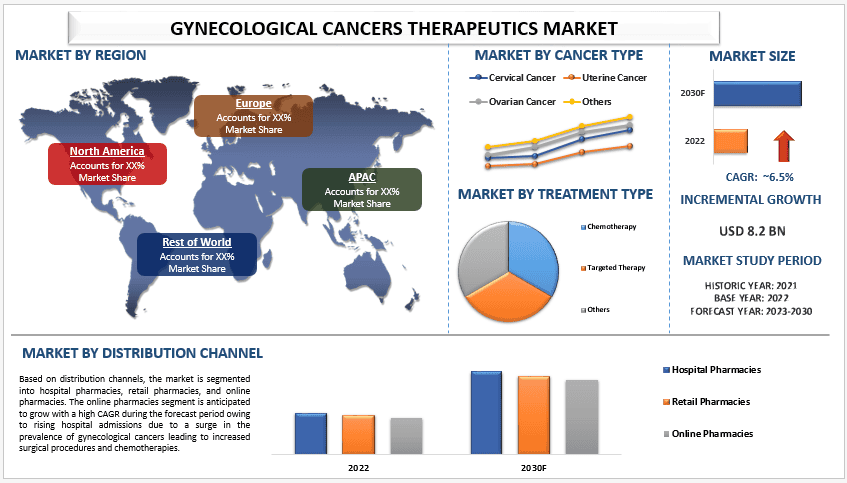
Global Gynecological Cancers Therapeutics Market was valued at USD 3.2 billion in 2022, growing at a CAGR of 6.5% during the forecast period from 2023 – 2030 to reach USD 8.2 billion by 2030. Gynecological cancer therapeutics services mainly gained prominence due to the increased cases of gynecological cancer globally. There has been a significant rise in the market due to this driving factor. In addition to this, investments in oncology departments as well as government awareness programs regarding gynecological cancers have increased significantly in recent years, which are the key factors that are creating opportunities for the market. For instance, In August 2020 the World Health Assembly adopted the Global Strategy for cervical cancer elimination to eradicate cancer from society. Many other factors were identified that helped in propelling the market in the forecast period such as the surge in awareness programs regarding gynecological cancers, the increasing smoking population, rising alcoholism culture are also driving the growth of the market.
Amgen Inc.; AstraZeneca; AbbVie Inc.; Bristol Myers Squibb Company; GSK plc.; Lilly; Merck KGaA; Pfizer Inc.; Novartis AG; and Sanofi are some of the key players in the market. Several M&As along with partnerships have been undertaken by these players to facilitate customers with hi-tech and innovative products/technologies.
Insights Presented in the Report
“Amongst cancer type, uterine cancer category to witness higher CAGR during the forecast period”
Based on cancer type, the market is segmented into cervical cancer, uterine cancer, ovarian cancer, and others. The uterine cancer segment is expected to grow with a high CAGR during the forecast period as there is a growing trend of tobacco use, including smoking and chewing tobacco and excessive alcohol use. Also, a diet lacking in fruits and vegetables, exposure to occupational toxic substances, and rising incidences of viral infections, including human papillomavirus and Epstein Barr virus are boosting its growth in the market. Oncology-specific pharmaceutical companies keep on launching enhanced therapeutics for the sake of the well-being of patients. For instance, in September 2023, the U.S. FDA granted fast-track designation to MorphoSys’ tulmimetostat for use as a potential therapeutic option in patients with advanced, recurrent, or metastatic endometrial cancer harboring ARID1A mutations and whose disease had progressed on at least 1 prior line of therapy. Thus, amongst cancer types, the uterine category is expected to witness higher CAGR during the forecast period.
“Amongst treatment type, chemotherapy held a significant share in the market in 2022”
Based on treatment type, the market is categorized into chemotherapy, targeted therapy, and others. The chemotherapy segment is dominating the market in 2022 owing to the maximum effectiveness of chemotherapy in killing cancer cells using X-rays and protons to deliver radiation to the cancer cells. Additionally, there has been increased incidences of gynecological cancers globally which is a driving factor for this segment. For instance, according to mesothelioma.com’s report in June 2023, 25% of cancer patients receive chemo each year in the U.S., when compared to forgoing treatment, chemotherapy can double survival for some patients. Thus, among treatment types, chemotherapy held a significant share of the market in 2022.
“Amongst distribution channels, the online pharmacies segment to grow with high CAGR during the forecast period”
Based on distribution channels, the market is segmented into hospital pharmacies, retail pharmacies, and online pharmacies. The online pharmacies segment is anticipated to grow with a high CAGR during the forecast period owing to rising hospital admissions due to a surge in the prevalence of adoption of digital platforms. Other factors, including ease of getting medications, faster delivery, user-friendly digital platforms, discounts and offers, and rising patient awareness levels for gynecological cancers in developed countries are factors expected to result in the dominance of the segment during the forecast period. For instance, in January 2022, U.S.-based Mark Cuban’s online pharmacy, Cost Plus Drug Co. was launched to allow cancer patients to order pocket-friendly medications. Thus, amongst distribution channels, online pharmacies are expected to witness a higher CAGR during the forecast period.
“Amongst regions, North America held a significant share of the market in 2022”
For a better understanding of the market adoption of gynecological cancers therapeutics, the market is analyzed based on its worldwide presence in countries such as North America (U.S., Canada, and Rest of North America), Europe (Germany, U.K., France, Spain, Italy, Rest of Europe), Asia-Pacific (China, Japan, India, Rest of Asia-Pacific), Rest of World. North America is dominating the market in the current scenario of 2022 due to the increasing smoke pollution, increasing alcohol consumption, and rising number of investments in developing effective gynecological cancer therapeutics. Government organizations are initiating gynecological cancer awareness programs to provide efficient care to patients. For example, according to the Globocan 2020 report, an estimated 2,281,658 new cancer cases were diagnosed in the U.S. in 2020. Thus, amongst regions, North America held a significant share of the market in 2022.
Gynecological Cancers Therapeutics Market Report Coverage
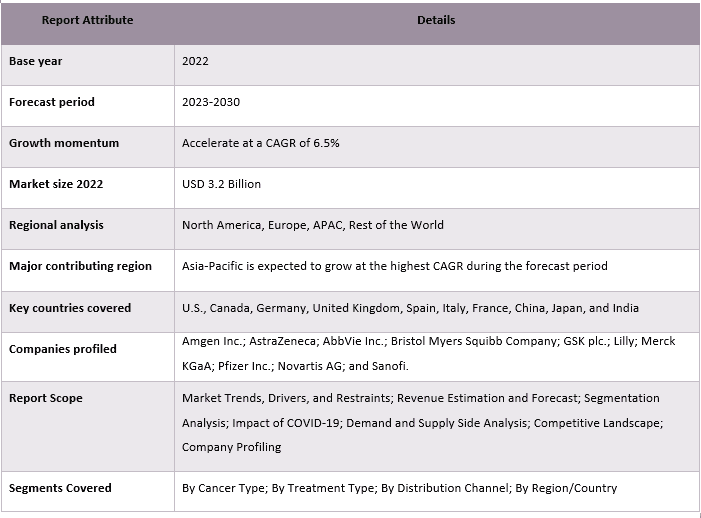
Reasons to buy this report:
- The study includes market sizing and forecasting analysis validated by authenticated key industry experts.
- The report presents a quick review of overall industry performance at one glance.
- The report covers an in-depth analysis of prominent industry peers with a primary focus on key business financials, product portfolio, expansion strategies, and recent developments.
- Detailed examination of drivers, restraints, key trends, and opportunities prevailing in the industry.
- The study comprehensively covers the market across different segments.
- Deep dive regional level analysis of the industry.
Customization Options:
The global gynecological cancers therapeutics market can further be customized as per the requirement or any other market segment. Besides this, UMI understands that you may have your own business needs, hence feel free to connect with us to get a report that completely suits your requirements.
Table of Content
Research Methodology for the Gynecological Cancers Therapeutics Market Analysis (2023-2030)
Analyzing the historical market, estimating the current market, and forecasting the future market of the global gynecological cancers’ therapeutics market were the three major steps undertaken to create and analyze the adoption of gynecological cancer therapeutics in major regions globally. Exhaustive secondary research was conducted to collect the historical market numbers and estimate the current market size. Secondly, to validate these insights, numerous findings and assumptions were taken into consideration. Moreover, exhaustive primary interviews were also conducted, with industry experts across the value chain of the global gynecological cancers therapeutics market. Post assumption and validation of market numbers through primary interviews, we employed a top-down/bottom-up approach to forecasting the complete market size. Thereafter, market breakdown and data triangulation methods were adopted to estimate and analyze the market size of segments and sub-segments of the industry pertains to. Detailed methodology is explained below:
Analysis of Historical Market Size
Step 1: In-Depth Study of Secondary Sources:
Detail secondary study was conducted to obtain the historical market size of the gynecological cancers therapeutics market through company internal sources such as annual reports & financial statements, performance presentations, press releases, etc., and external sources including journals, news & articles, government publications, competitor publications, sector reports, third-party database, and other credible publications.
Step 2: Market Segmentation:
After obtaining the historical market size of the gynecological cancers therapeutics market, we conducted a detailed secondary analysis to gather historical market insights and share for different segments & sub-segments for major regions. Major segments are included in the report as cancer type, treatment type, distribution channel, and regions. Further country-level analyses were conducted to evaluate the overall adoption of testing models in that region.
Step 3: Factor Analysis:
After acquiring the historical market size of different segments and sub-segments, we conducted a detailed factor analysis to estimate the current market size of the gynecological cancers therapeutics market. Further, we conducted factor analysis using dependent and independent variables such as cancer type, treatment type, distribution channel, and regions of gynecological cancers therapeutics. A thorough analysis was conducted for demand and supply-side scenarios considering top partnerships, mergers and acquisitions, business expansion, and product launches in the gynecological cancers therapeutics market sector across the globe.
Current Market Size Estimate & Forecast
Current Market Sizing: Based on actionable insights from the above 3 steps, we arrived at the current market size, key players in the global gynecological cancers therapeutics market, and market shares of the segments. All the required percentage shares split, and market breakdowns were determined using the above-mentioned secondary approach and were verified through primary interviews.
Estimation & Forecasting: For market estimation and forecast, weights were assigned to different factors including drivers & trends, restraints, and opportunities available for the stakeholders. After analyzing these factors, relevant forecasting techniques i.e., the top-down/bottom-up approach were applied to arrive at the market forecast for 2030 00for different segments and sub-segments across the major markets globally. The research methodology adopted to estimate the market size encompasses:
- The industry’s market size, in terms of revenue (USD) and the adoption rate of the gynecological cancers therapeutics market across the major markets domestically
- All percentage shares, splits, and breakdowns of market segments and sub-segments
- Key players in the global gynecological cancers therapeutics market in terms of products offered. Also, the growth strategies adopted by these players to compete in the fast-growing market
Market Size and Share Validation
Primary Research: In-depth interviews were conducted with the Key Opinion Leaders (KOLs) including Top Level Executives (CXO/VPs, Sales Head, Marketing Head, Operational Head, Regional Head, Country Head, etc.) across major regions. Primary research findings were then summarized, and statistical analysis was performed to prove the stated hypothesis. Inputs from primary research were consolidated with secondary findings, hence turning information into actionable insights.
Split of Primary Participants in Different Regions
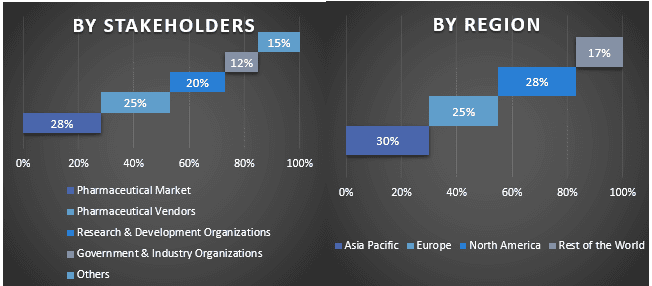
Market Engineering
The data triangulation technique was employed to complete the overall market estimation and to arrive at precise statistical numbers for each segment and sub-segment of the global gynecological cancers therapeutics market. Data was split into several segments & sub-segments post studying various parameters and trends in the areas of cancer type, treatment type, distribution channel, and regions in the global gynecological cancers therapeutics market.
The main objective of the Global Gynecological Cancers Therapeutics Market Study
The current & future market trends of the global gynecological cancers therapeutics market were pinpointed in the study. Investors can gain strategic insights to base their discretion for investments on the qualitative and quantitative analysis performed in the study. Current and future market trends determined the overall attractiveness of the market at a regional level, providing a platform for the industrial participant to exploit the untapped market to benefit from a first-mover advantage. Other quantitative goals of the studies include:
- Analyze the current and forecast market size of the gynecological cancers therapeutics market in terms of value (USD). Also, analyze the current and forecast market size of different segments and sub-segments
- Segments in the study include areas of cancer type, treatment type, distribution channel, and regions
- Define and analyze the regulatory framework for the gynecological cancers therapeutics industry.
- Analyze the value chain involved with the presence of various intermediaries, along with analyzing customer and competitor behaviors of the industry.
- Analyze the current and forecast market size of the gynecological cancers therapeutics market for the major region.
- Major countries of regions studied in the report include Asia Pacific, Europe, North America, and the Rest of the World.
- Company profiles of the gynecological cancers therapeutics market and the growth strategies adopted by the market players to sustain in the fast-growing market
- Deep dive regional level analysis of the industry
Frequently Asked Questions FAQs
Q1: What is the current market size and growth potential of the gynecological cancers’ therapeutics market?
Q2: What are the driving factors for the growth of the gynecological cancers’ therapeutics market?
Q3: Which segment has the largest share of the gynecological cancers’ therapeutics market by cancer type?
Q4: What are the emerging technologies and trends in the gynecological cancers’ therapeutics market?
Q5: Which region will dominate the gynecological cancers’ therapeutics market?
Q6: Who are the key players operating in the gynecological cancers’ therapeutics market?
Related Reports
Customers who bought this item also bought


